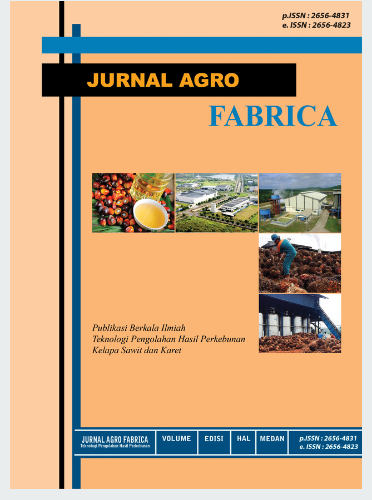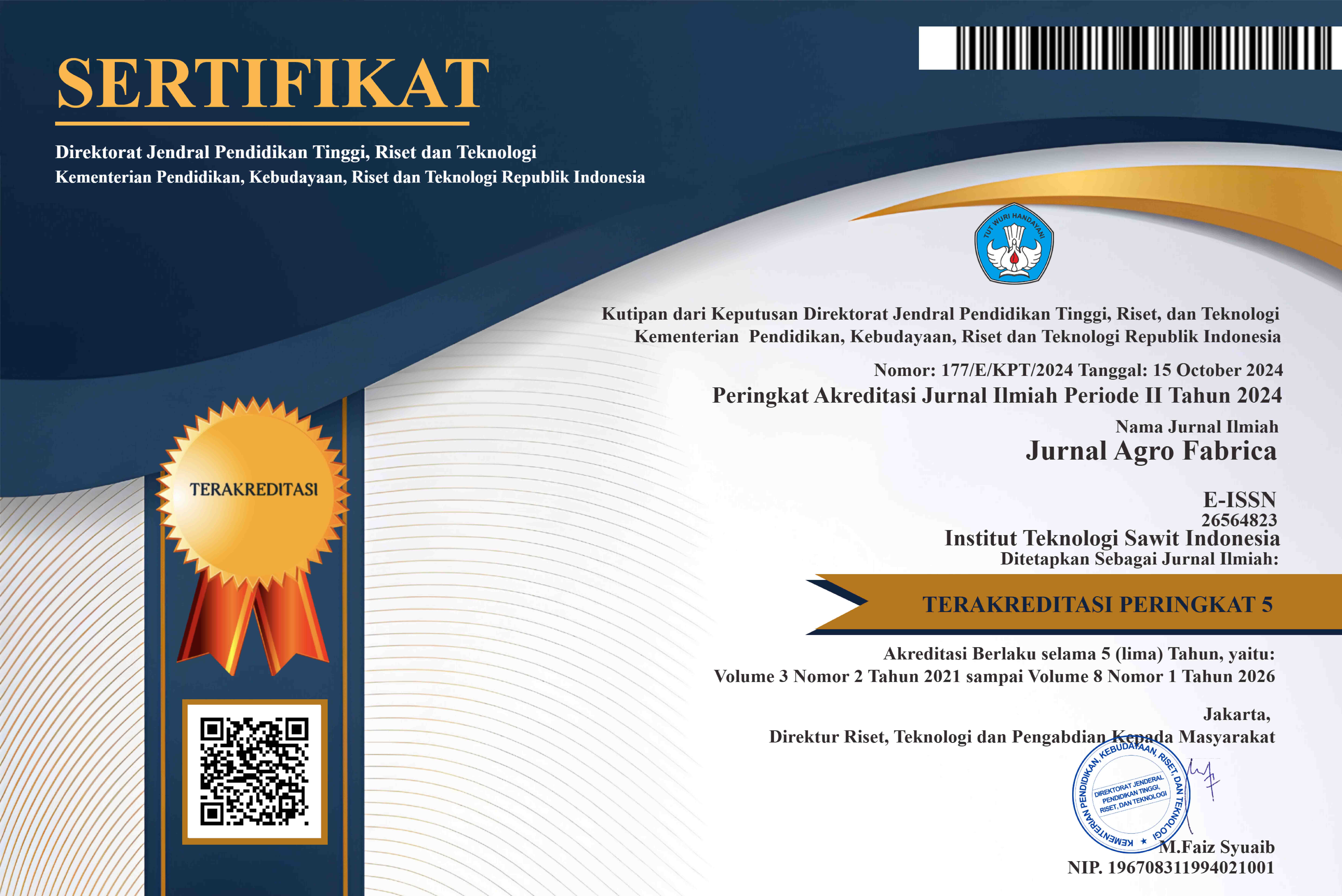STUDI EFEKTIVITAS PENGUTIPAN MINYAK PADA CONTINUOUS SETTLING TANK MENGGUNAKAN ALAT PELAMPUNG
DOI:
https://doi.org/10.47199/jaf.v6i2.274Keywords:
continuous settling tank, float, clarification station, palm oil millAbstract
The Continuous Settling Tank (CST) is a tank at the clarification station of a palm oil mill used for the sedimentation process of oil, water, and sludge. The optimal performance of the CST is evaluated based on the overflow produced, considering the quality of water content and the level of oil impurities according to standards. Controlling the percentage of impurities in the oil requires an optimal thickness level during collection. The thickness of the fluid layer in the CST tank can be measured using a bamboo stick. However, the bamboo used to measure the fluid thickness is inaccurate because the bamboo inserted into the CST tank, with the expectation that sludge will adhere to it, is often cleaned by the oil layer, and the bamboo has to be inserted repeatedly, making it inefficient. Therefore, it is necessary to create a device to measure oil thickness based on Archimedes' principle, using a float. The objective of this research is to create a measuring device to control the quality of crude oil in the Continuous Settling Tank based on the oil thickness. The design of this research uses two methods: descriptive and experimental. The research results show that after the implementation of the measuring device as a thickness indicator, oil quality control in the CST becomes efficient. With an oil thickness of 50 cm, the average quality of crude oil is observed to be the best, with a water content of 0.45% and an impurity level of 0.49%.
Downloads
References
Damayanti, Y., Lesmono, A. D., & Prihandono, T. (2019). Kajian Pengaruh Suhu Terhadap Viskositas Minyak Goreng Sebagai Rancangan Bahan Ajar Petunjuk Praktikum Fisika 1). Jurnal Pembelajaran Fisika, 7(3), 308–314.
Hudori, M. (2014). Analisa faktor penyebab tingginya kadar kotoran pada produksi Minyak kelapa sawit. Citra Widya Edukasi, Tabel 1, 21–27.
Lubis, D. T. (2023). Instalasi Automatic Valve Drain Sand Trap Tank Pabrik Kelapa Sawit. Jurnal Informatika Dan Perancangan Sistem, 5(1), 63–70.
Mahfud, A. (2017). Rancang Bangun Sensor Pelampung Untuk Mendeteksi Ketebalan Lapisan Fluida Di Continuous Settling Tank Dengan Memanfaatkan Sensor Magnet (Reed Switch). Industrial Engineering Journal, 6(2), 17–22.
Mutmainah, H. (2019). Sebaran dan Karakteristik Tumpahan CPO di Teluk Bayur Serta Dampaknya Terhadap Kualitas Air. 6th ACE Conference, 999–1008.
Nugroho, A. (2019). Teknologi Agroindustri Kelapa Sawit. In Lambung Mengkurat Universitas Press (Issue August). https://www.researchgate.net/profile/Agung-Nugroho- 13/publication/337315913_Buku_Teknologi_Agroindustri_ Kelapa_Sawit/links/5dd1694792851c382f469b34/Buku- Teknologi-Agroindustri-Kelapa-Sawit.pdf
Setiyadi, Lourentius, S., W, E. A., & Prema, G. (2020). Menentukan Persamaan Kecepatan Pengendapan pada Sedimentasi. Jurnal Ilmiah Widya Teknik, 10(1), 9–17.
Winarni, Iswanto, B., & Karina, C. (2015). Pengaruh Pengadukan Pada Koagulasi Menggunakan Alum. Indonesian Journal of Urban and Environmental Technology, 5(6), 201. https://doi.org/10.25105/urbanenvirotech.v5i6.694
Downloads
Published
How to Cite
Issue
Section
License
Copyright (c) 2024 Jurnal Agro Fabrica

This work is licensed under a Creative Commons Attribution-ShareAlike 4.0 International License.




















